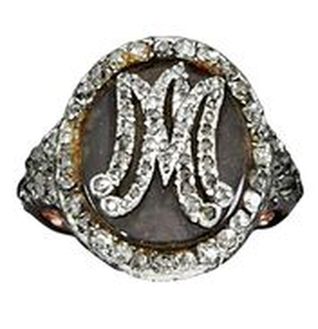news.internetstones.comから文章と画像。試訳。
****
SOTHEBYS UNVEILS FURTHER HIGHLIGHTS OF THE UNSEEN TREASURES FROM THE BOURBON-PARMA ROYAL JEWELRY COLLECTION
サザビーズ、「ブルボン=パルマ王家の宝飾コレクション」から一般の目に触れることのなかった宝飾品を追加発表
November 7, 2018 by Mr Lareef Samad
2018年11月7日
Sotheby’s Auction House after its first announcement in June 2018, on the sale of the most significant noble jewelry collections ever to come up for auction, christened “Royal Jewels from the Bourbon-Parma Family”, at their Geneva Sale, due to be held on 14th November 2018, have in another press release dated 22nd October, 2018, unveiled further unseen treasures from this incomparable royal jewelry collection. These include additional jewels once owned by the ill-fated Queen of France Marie Antoinette and other opulent pieces from the former Kings of France, the Austrian Imperial Family and the Dukes of Parma.
オークションハウスのサザビーズは、2018年6月、「ブルボン=パルマ家の王室宝飾品」と題したオークション史上に残る豪華絢爛な宝飾品コレクションのオークションが、2018年11月14日にジュネーブで開催されることを発表した。このほど2018年10月22日に再度記者会見を開催し、初めて公開される素晴らしい宝飾品を新たに発表した。悲劇のフランス王妃マリー・アントワネットが所有していた宝石や、元フランス国王、オーストリア皇帝一族、パルマ公爵が所有していた宝飾品だ。
Marie Antoinette’s impressive collection of jewels and how they escaped confiscation during the tumultuous days of the French revolution, has a story as extraordinary as the jewels themselves. Her love of pearls and diamonds is well-known, to the extent that historians have ventured to say, that never in the course of history has the destiny of a queen been so closely associated with jewels than that of Marie Antoinette, citing Napoleon’s view, that the so-called “affair of the diamond necklace” – a scandal which tarnished the queen’s reputation in 1785 – was one of the contributory factors for the French Revolution.
マリー・アントワネットの見事な宝飾品とそれらがフランス革命の混乱期にどのように押収を免れたかという物語は、宝石それ自体と同様に並外れたものだ。アントワネットの真珠やダイヤモンドへの愛着はよく知られているが、歴史家をしてマリー・アントワネットほど王妃の運命と宝飾品を密接に関連付けられたことは歴史上他に例がないと言わしめ、ナポレオンの言葉を引用し、いわゆる「ダイヤモンドの首飾り事件」(1785年にアントワネットの評判を貶めたスキャンダル)は、フランス革命の要因の一部だとさえ語っている。
In March of 1791 as King Louis XVI, Queen Marie Antoinette and their children were preparing their escape from France, according to Marie Antoinette’s lady in waiting, Madame Campan, the queen spent an entire evening in the Tuileries Palace wrapping all of her diamonds, rubies and pearls in cotton and placing them in a wooden chest. The jewels were subsequently sent to Brussels, which was under the rule of the queen’s sister, Archduchess Marie-Christine and was home to Count Mercy Argentau, the former Austrian Ambassador to Paris, who was one of the only men who had earned the Queen’s trust. Count Mercy Argentau took delivery of the jewels and sent them to Vienna, for safe keeping under the custody of the Austrian Emperor, who was Marie Antoinette’s nephew. The collection included 10 jewels which belonged to Marie Antoinette.

Florimond Claude, comte de Mercy-Argenteau (20 April 1727 – 25 August 1794) /Wikipedia メルシー=アルジャントウ伯爵
マリー・アントワネットの首席侍女だったカンパン夫人によると、1791年3月、チュイルリー宮殿で、国王ルイ16世、王妃マリー・アントワネット、そして王女・王太子がフランスを脱出する準備を進めていたとき、アントワネットは一晩かけてダイヤモンド、ルビー、真珠を全て布にくるみ木製のチェストにしまった。宝飾品はその後ブリュッセルに送られた。ブリュッセルは当時アントワネットの姉、マリー=クリスティン大公妃が治めており、また、パリの元オーストリア大使でアントワネットの信頼が厚かったメルシー・アルジャントウ伯爵の出身地でもあった。伯爵は、アントワネットの甥であるオーストリア皇帝のもとで保管するため、宝飾品をウィーンに運ばせた。今回のコレクションの中の10点は、マリー・アントワネットが所有していたものだ。
In 1792, the Royal family was arrested and imprisoned in the Temple Tower. King Louis XVI was executed by guillotine in January 1793, followed by his Queen, Marie Antoinette in October 1793. Their 10-year old son, Louis XVII, died in captivity and their only surviving child, Marie-Thérèse de France (1778-1851),“Madame Royale”, was released in December 1795, after three years of solitary confinement.

Marie-Thérèse in Vienna in 1796 soon after her departure from Revolutionary France. /Wikipedia 革命政府から解放されウィーンに到着した当時のマダムロワイヤル(18)
1792年、国王一家は捕えられタンプル塔に幽閉された。国王ルイ16世は1793年1月にギロチンにかけられ、王妃マリー・アントワネットは同年10月に処刑された。10歳の王子、ルイ17世は囚われの身のままで死に、唯一生き残った王女、マリー・テレーズ・ド・フランス(1778-1851)「マダム・ロワイヤル」は、3年間独房に監禁された後、1795年12月に解放された。
Marie-Thérèse was sent to Austria after learning of the deaths of her mother and brother. After her arrival in Vienna in 1796, she was given her mother’s jewels by her cousin, the Holy Roman Emperor Francis II. Marie-Thérèse married her first cousin Louis Antoine, Duke of Angoulême, in 1799, who was the eldest son of the future King Charles X, her father’s younger brother. Marie-Thérèse, the Duchess of Angoulême, became the Dauphine of France, wife of heir to the throne of France Louis Antoine, when her father-in-law ascended the throne of France as King Charles X in 1824.
マリー・テレーズは王妃と王子の死を知った後、オーストリアに送られた。1796年にウィーンに到着すると従兄弟である神聖ローマ皇帝フランツ2世からアントワネットの宝飾品を受け取った。1799年、従兄弟にあたるルイ・アントワーヌ・アングレーム公爵と結婚した。公爵は、ルイ16世の弟で後の国王シャルル10世の長男だった。1824年に義理の父が国王シャルル10世として王位に就いた時、マリー・テレーズ、アングレーム公爵夫人は、フランス王位継承者である王太子ルイ・アントワーヌの王太子妃となった。
She remained in France until August 2, 1830, when King Charles X abdicated the throne and the Chamber of Deputies appointed his cousin Louis Philippe as the King of France. Marie-Thérèse again went into exile in the UK with Charles X, her husband Louis Antoine, her young nephew duc de Bordeaux, his mother, the duchesse de Berry, and his sister Louise Marie Thérèse d’Artois, where they remained until 1833. Later they moved to Prague and finally to Austria, where they lived until their final days.
1830年8月2日、国王シャルル10世が退位させられ議会が従兄弟のルイ・フィリップをフランス人の王に就くことを承認した時、マリー・テレーズはフランスを去った。シャルル10世、夫のルイ・アントワーヌ、幼い甥のボルドー公、その母親であるベリー公爵夫人、姉のルイーズ・マリー・テレーズ・ダルトワと共に、再び英国に亡命し1833年まで滞在した。その後、プラハに移住し最終的にオーストリアに落ち着いた。
Having borne no children of her own, Marie-Thérèse de France bequeathed part of her jewelry collection to her niece and adopted daughter, Louise of France (1819–1864), Duchess of Parma and grand-daughter of Charles X, King of France (1757-1836), who in turn left them to her son, Robert I (1848-1907), the last ruling Duke of Parma.

Louise d’Artois with her son Roberto I as Regent of Parma, Carlini 1854 /Wikipedia ルイーズ・ダルトワ・パルマ公爵夫人と王子ロベルト1世
マリー・テレーズ・ド・フランスには子供がいなかったため、姪であり義理の娘、フランス国王シャルル10世(1757-1836)の孫娘のルイーズ・ド・フランス、パルマ公爵夫人(1819–1864)に宝飾品の一部を遺贈し、次に公爵夫人は息子で最後のパルマ公ロベルト1世(1848-1907)に譲った。

Important pair of natural pearl and diamond pendent earrings, late 18th century / アントワネット→マダムロワイヤル→ルイーズ・マリーテレーズ・パルマ公爵夫人
/

These pearls were originally strung in a three row pearl necklace, belonging to Queen Marie Antoinette. / アントワネットが所有してた3連真珠ネックレス(上画像中でパルマ公爵夫人が着用)の一部
/

The clasp was formerly part of a six row pearl bracelet – one of a pair – which belonged to Queen Marie Antoinette (1755-1793). アントワネットが所有していた当時は6連真珠のブレスレット
/

The double ribbon bow from Marie Antoinette, Queen of France (1755-1793). / アントンワネットはリボンの部分を所有
/

1 ring with hair and monogram (M.A. set with diamonds) / アントワネットのモノグラムと髪の毛
/

By family tradition, the diamonds come from Marie Antoinette, Queen of France (1755-1793). / アントワネットが所有していたダイヤモンド
/

The case applied with blue and white enamel and set with seed pearls, opening to reveal a circular dial with Arabic numerals, inside of the case engraved with the letters M A and three fleur-de-lys motifs, and with the letters L.D.S. D.M.M., fitted case stamped J.F. Bautte. / アントワネットが所有していた懐中時計。ムーブメントは後世に変更。
/
